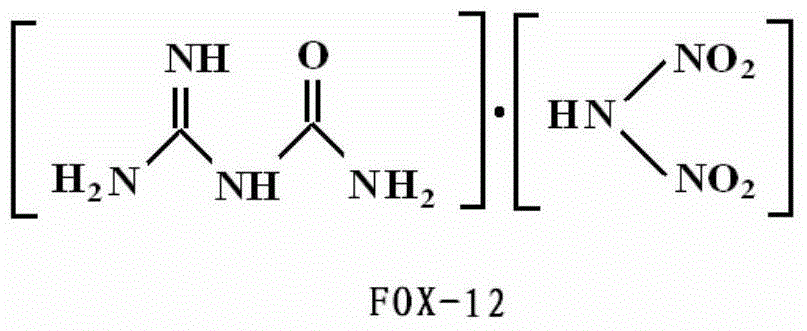Heat-resistant solid propellant for oil-gas deep well and preparation method of heat-resistant solid propellant
A solid propellant, high temperature resistance technology, applied in offensive equipment, inorganic oxyhalide salt explosive compositions, explosives and other directions, can solve the problem of inability to use, and achieve the effect of good temperature resistance and excellent hydrolysis resistance.
- Summary
- Abstract
- Description
- Claims
- Application Information
AI Technical Summary
Problems solved by technology
Method used
Image
Examples
preparation example Construction
[0031] The preparation method of the above-mentioned high-temperature-resistant solid propellant for oil and gas deep wells, the method is carried out according to the following steps:
[0032] Step 1, according to the formula ratio, by weight percentage, the high temperature resistant epoxy resin is 5.59% to 26.79%, the bisphenol A epoxy resin is 1.77 to 10.38%, and the epoxy resin reactive diluent is 6.04 to 13.70%. Add 0.50% accelerator and 0.03% defoamer into the mixing pot, and pre-mix for 10 minutes;
[0033] Step 2: Add 45.00% to 65.00% of potassium perchlorate and 0.00% to 10.00% of N-amidinourea dinitramide salt to the system of step 1 in terms of weight percentage. After mixing for 50 minutes, add diaminodiphenyl The sulfone content is 4.80%-9.87%. After mixing for 15 minutes, stop mixing to obtain a syrup;
[0034] Step 3: pour the slurry obtained in Step 2 into a mold, put it in an oven at 130°C for 72 hours, and remove the mold to obtain a finished high-temperatu...
Embodiment 1
[0037] The weight percentage composition of this embodiment: potassium perchlorate is 55.00%, N-guanidinourea dinitramide salt is 5.00%, TGDDM is 14.40%, epoxy resin E-51 is 8.30%, o-cresyl glycidyl ether is 9.41% , accelerator boron trifluoride - amine complex 0.50%, silicone resin 0.03%, diaminodiphenyl sulfone 7.36%.
[0038] Performance Testing:
[0039] Detonation heat is determined by GJB770B-2005 method 701.2 detonation heat and combustion heat constant temperature method.
[0040] The specific volume is measured according to GJB770B-2005 method 702.1 specific volume pressure sensor method.
[0041] The test method for high temperature resistance is: Ф20mm×20mm powder column (1) 3°C / min rise to 200°C, keep warm for 48h; (2) Temperature control point: the thermocouple is suspended directly above the sample, not in contact with the sample. The thermal weight loss of the sample is not more than 3%, and the test is passed if it is neither flammable nor explosive. DSC exo...
Embodiment 2
[0045] The weight percentage composition of this embodiment: potassium perchlorate is 45.00%, N-guanidinourea dinitramide salt is 10.00%, TGDDM is 26.79%, epoxy resin E-51 is 1.77%, o-cresyl glycidyl ether is 6.04% , accelerator boron trifluoride - amine complex 0.50%, silicone resin 0.03%, diaminodiphenyl sulfone 9.87%.
[0046] The performance test method of the high-temperature-resistant solid propellant for oil and gas deep wells in this embodiment is the same as that in Embodiment 1, and the performance test results are shown in Table 2.
PUM
| Property | Measurement | Unit |
|---|---|---|
| particle size | aaaaa | aaaaa |
| viscosity | aaaaa | aaaaa |
| viscosity | aaaaa | aaaaa |
Abstract
Description
Claims
Application Information
 Login to View More
Login to View More - R&D
- Intellectual Property
- Life Sciences
- Materials
- Tech Scout
- Unparalleled Data Quality
- Higher Quality Content
- 60% Fewer Hallucinations
Browse by: Latest US Patents, China's latest patents, Technical Efficacy Thesaurus, Application Domain, Technology Topic, Popular Technical Reports.
© 2025 PatSnap. All rights reserved.Legal|Privacy policy|Modern Slavery Act Transparency Statement|Sitemap|About US| Contact US: help@patsnap.com



